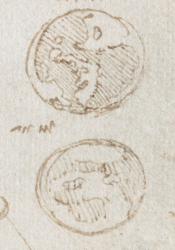Invention of the Telescope
The first iteration of the modern telescope experienced its first patent attempt by Hans Lippershey in the Netherlands in 1608. While not granted the patent due to its lack of difficulty to produce, this attempt is widely regarded as its conception. However, over a hundred years before, da Vinci had already been performing experiments with lenses which increased his sight, allowing him to observe surface features of the moon that were barely visible to the human eye. As optics was one of his great interests and drove his fascination with astronomy, Leonardo’s main focus was defining the physical features of the moon. Using concave and convex lenses, a similar theory to telescopes, he made a generalized map of the moon, noting the lighter and darker areas, as seen in the attached image. Based on its reflectivity, he proposed that it contained moving seas in the lighter areas, and land masses in the darker regions, similar to the structure of the Earth. While this theory was later proved wrong, and the darker areas were found to be made of basalt and the lighter mountainous highlands, Leonardo’s hypotheses involving the physical features of the moon were the first real steps towards truly identifying a key feature in our night sky.
Works Cited:
Leonardo, & Richter, Jean Paul. (1883). The literary works of Leonardo da Vinci. S. Low, Marston, Searle & Rivington.
StarChild: The Moon. (n.d.). Retrieved February 8, 2020, from https://starchild.gsfc.nasa.gov/docs/StarChild/solar_system_level2/moon....
Welther, B. L. (1999, October). Leonardo da Vinci and the Moon : The famous Renaissance artist and scientist made an insightful interpretation about our nearest neighbor in space. Sky & Telescope, 98(4), 40. Retrieved from https://link.gale.com/apps/doc/A55874615/AONE?u=purdue_main&sid=AONE&xid...
Wilson, T. (2017, October 11). This Month in Astronomical History: The Invention of the Telescope. Retrieved February 8, 2020, from https://aas.org/posts/story/2017/10/month-astronomical-history-invention...

